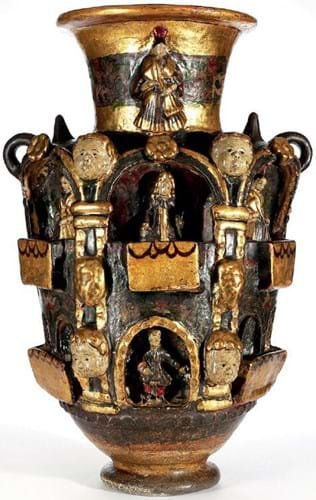
This lavishly gilded and decorated redware vessel from Viceregal Mexico is one of a small group of Tonalá tibors or jars produced between 1695-1730. It is currently available from E&H Manners for £75,000.
Decorated with unfired paint and gold and silver leaf over a gesso or lime wash layer, the jar features Spanish colonial figures in balconies as well as larger applied children’s heads and a figure of a lady with a fan and high mantilla on the neck. Flora and felines are joined by what may be coati, a type of Central American raccoon.
Redwares from Tonalá were highly prized in Europe for their exoticism as well as their inherent scent, which was released from the clay when filled with water. They were also believed to have medicinal virtues.
In 1675 Count Lorenzo Magalotti said of redwares: “They are counted amongst the essential adornments of all mansions which have pretensions to supreme elegance. They shine as precious works of art in the palaces of kings and princes.”
In Velasquez’s Las Meninas the Infanta Margarita is seen receiving one from her lady in waiting. There are comparable examples in the Museo de América in Madrid.
The present example comes from a private collection in France and is included in a selection of highlight works in the March edition of E&H Manners’ subscription email newsletter.














